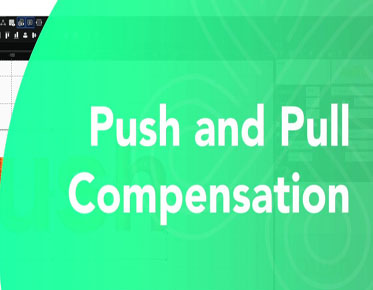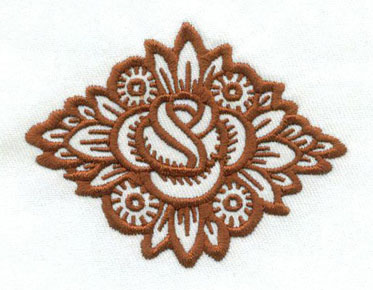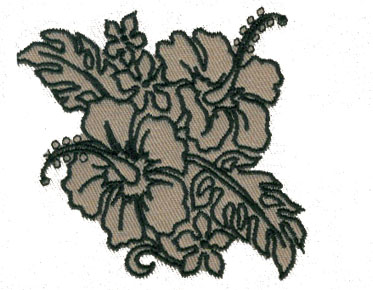The Basics of Push & Pull Compensation for Embroidery Digitizing
You know about the push-pull balancing machine, and you know it's necessary, but when people talk about it, do you think it's going to be an explanation for the science of rocket science? It might sound confusing, but it isn't! Eagle Digitizing here to help explain! Regardless of whether you are a beginner or a skilled digitizer, the theory of learning is crucial for producing high-quality embroidery.
What is push-pull compensation in embroidery digitization?
Since the early days of embroidery, all machines have created stitches in the same way. There is a top line and a line axis, and they both have tension. Once these two threads intersect with the time of the machine's needle scarf and spool hook, they pull on each other to create a flat stitch.
If there is no tension in the top and bottom threads, the embroidery will not be flat and will have a loose and looped look. This is called embroidery distortion and occurs due to tension issues on the embroidery machine.
The deformation occurs because of how the top and thread axis react to each other when applied to different fabric types. The name for this reaction is often referred to as "push-pull compensation" The stitches in the satin posts have a pulling effect, making the posts slightly thinner as they are sewn. The open end of the satin post, whichever end you can slide the pin on, is where the push effect comes into play. When push-pull comes into play, the width of the thread and the density of the stitches can deform the fabric.
Embroidery digitization tension compensation
Pull compensation is a tool built into the embroidery software. When activated, your software will override the width of the column seam. With most software programs, you can control the amount of tension compensation required for the design object to be digitized. You must understand when and why you need to adjust this setting.
The rule of thumb is that the wider the pin, the more pull compensation you need to apply. Why? Because the wider the stitch, the more tension on the top and bottom threads creates a flat stitch on the fabric. The image above shows how the column width increases as the column width increases, you also need to increase the setting for the pull compensation. You'll notice that the 2mm column width has only 0.15mm of pull compensation applied, and that gradually increases to 7mm columns with 0.3mm of pull compensation.
The wider the stitch, the more pull compensation you need to apply. Remember, these rules are not set in stone. Another factor that can affect the amount of tension compensation is the type of material being embroidered. For example, denim requires less tension compensation than stretch terry.
Pull compensation is a great tool in software because it makes digitizing much easier if you understand the theory behind it. In the days before the software, we manually overturned each stitch to adjust the column width. I remember it was a very tedious process.
Promote embroidery digital compensation
Unfortunately, the "push" that happens is something the software can't control automatically. The knack of learning how to control the "push" takes some time and practice to master, and is largely related to digitization at a consistent scale. When you manually adjust Push Compensation, you need to cut or pull the object node back in the direction of the stitch being created.
So the question is, how many nodes of the object should I cut from the open end when I digitize on the screen? Generally, the rule is that you want to place your input about a stitch (~0.4mm) short of how your artwork will appear on the screen.
By digitizing at a consistent scale, the amount you shorten is always the same, and you don't have to guess like constantly zooming in and out at different scales on the screen. like most embroidery-related rules, this rule can be changed in different situations.
For example, let's say you're creating a satin stitch and then placing a continuous stitch around it to create an outline effect in different colors. In this case, you will need to reduce the satin stitch node by two stitches (about .8mm), then digitize the running stitch, placing the running stitch points precisely on the artwork.
If you cut the satin stitch too little, you may see a gap between the stitches of the two colors. That satin sewing thread may extend over the running stitch and if you don't cut it far enough, it will look like a mistake. Again, most of the content is covered in greater depth in our Digitizer Dreams course, but for now, please understand that there is no one-size-fits-all approach for every design you plan to create.
Practice push-pull compensation on your own
To actually understand push-pull compensation, one of the easiest exercises is to digitize the perfect circle using long satin stitches. Remember: the longer the pins, the more you pull. First, digitize your dots exactly as the artwork; you'll see a perfect circle of satin stitching on the screen. Now take this design and run it on your machine; the result will be an object that looks like an egg! Embroidery is deformed due to push-pull compensation.
Now I want you to digitize the circles again. This time, I want you to cut back the open ends at the top and bottom and exaggerate the points on either side of the pin orientation. On the screen, you'll see what looks like a sideways egg; now, when you run this file on your embroidery machine, guess what? It will stitch out what looks like the original artwork and the result will be a perfect embroidered circle.
Push-pull compensation in action
For me, one of the easiest ways to know if a digitizer understands push-pull compensation is to check the letters they've digitized. I'm not talking about keyboard text or fonts built into your software or machine. If you don't use push-pull rules when creating lettering, you'll end up with text that looks very sloppy and uneven. We call it the baseline for dancing. This is when all the letters look uneven and some look bigger and smaller than others. The point is, you can't digitize text exactly the way you see it on the screen. The letter "L" has two open ends, a "T" has three, a "P" has one, and an "O" doesn't. This is why most software keyboard lettering sometimes works, sometimes works, and sometimes doesn't. People forget that someone physically digitized this font in the first place.
Depending on the software they use, it might just be an embroidery font consisting of stitch files that have been converted to keystrokes (like font packs sold as stitch files or most keyboard fonts). When these types of fonts are resized, they tend to lose their visual integrity quickly.
Any font created is only as good as the digitizer and the software they use. If the digitizer is inexperienced and the push-pull rule is not applied correctly, it goes without saying that the quality of the embroidery design will suffer.
Push-pull will affect fill stitches more significantly because fill is used to cover a large area - the larger the area, the more stitches.
The more stitches, the more the design deforms when applied to the fabric. This is usually why digitizers try to put a satin stitched border around the fill area to compensate for how the fill distorts the object. Even when digitizing fills with borders, you should still make "push-pull" adjustments to the fill before digitizing the satin stitch.
Proper push-pull compensation is essential for quality embroidery. Now, you know better than most how and why push-pull compensation in embroidery designs works. The next step is to practice and apply what you've learned!



